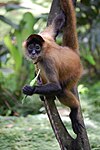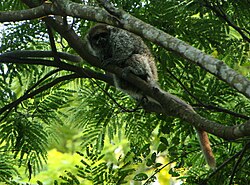Portal:Primates
The Primates Portal A primate is a member of the biological order Primates, the group that contains lemurs, the aye-aye, lorisids, galagos, tarsiers, monkeys, and apes, with the last category including great apes. With the exception of humans, who inhabit every continent on Earth, most primates live in tropical or subtropical regions of the Americas, Africa and Asia. Primates range in size from the 30-gram (1 oz) pygmy mouse lemur to the 200-kilogram (440 lb) mountain gorilla. According to fossil evidence, the primitive ancestors of primates may have existed in the late Cretaceous period around 65 mya (million years ago), and the oldest known primate is the Late Paleocene Plesiadapis, c. 55–58 mya. Molecular clock studies suggest that the primate branch may be even older, originating in the mid-Cretaceous period around 85 mya. Primates exhibit a wide range of characteristics. Some primates do not live primarily in trees, but all species possess adaptations for climbing trees. Locomotion techniques used include leaping from tree to tree, walking on two or four limbs, knuckle-walking, and swinging between branches of trees (known as brachiation). Primates are characterized by their large brains relative to other mammals. These features are most significant in monkeys and apes, and noticeably less so in lorises and lemurs. Many species are sexually dimorphic, which means males and females have different physical traits, including body mass, canine tooth size, and coloration.
Selected article
Pachylemur is an extinct, giant lemur most closely related to the ruffed lemurs of genus Varecia. Two species are known, Pachylemur insignis and Pachylemur jullyi, although there is some doubt as to whether or not they may actually be the same species. Pachylemur is sometimes referred to as the giant ruffed lemur, because although it and the living ruffed lemurs had similar teeth and skeletons, Pachylemur was more robust and as much as three to four times larger. DNA studies have confirmed a sister group relationship between these two types of lemur. Like living ruffed lemurs, Pachylemur specialized in eating fruit, and was therefore an important seed disperser, possibly for tree species with seeds too large for even ruffed lemurs to swallow. In the spiny thickets of southwestern Madagascar, they were also likely to have dispersed seeds evolved to attach to fur and be carried away. Unlike ruffed lemurs, the fore- and hindlimbs of Pachylemur were nearly the same length, and therefore it was likely to be a slow, deliberate climber. However, both used hindlimb suspension to reach fruit on small branches below them.
Like other lemurs, Pachylemur was only found on the island of Madagascar, and its subfossil remains have been found primarily at sites in the central and southwestern parts of the island. Fragmentary and indeterminate remains have also been found in northern Madagascar. Pachylemur once lived in diverse lemur communities within its range, but in many of these locations, 20% or fewer of the original lemur species remain. Pachylemur went into decline following the arrival of humans in Madagascar around 350 BCE. Habitat loss, forest fragmentation, and bushmeat hunting are thought to have been the reasons for its disappearance. Pachylemur is thought to have gone extinct between 680–960 CE, although subfossil remains found in a cave pit in southwestern Madagascar may indicate that it survived up until 500 years ago. Selected picture The ring-tailed lemur (Lemur catta) is a large strepsirrhine primate and the most recognized lemur due to its long, black and white ringed tail. It belongs to Lemuridae, one of five lemur families, and is the only member of the Lemur genus. Like all lemurs it is endemic to the island of Madagascar. Known locally in Malagasy as maky (spelled maki in French) or hira, it inhabits gallery forests to spiny scrub in the southern regions of the island. It is omnivorous and the most terrestrial of lemurs. The animal is diurnal, being active exclusively in daylight hours. CategoriesSelected species Least Concern (IUCN 3.1)|Least Concern The white-eared titi (Callicebus donacophilus), also known as the Bolivian titi or Bolivian gray titi, is a species of titi, a type of New World monkey, from eastern Bolivia and a small area of Brazil. It is a medium-sized monkey with a grey back, orange underside and distinctive white ear tufts. It has an omnivorous diet, eating fruits, other plant materials and invertebrates. It is predated upon primarily by raptors, though felids and other monkey species have been known to attack the species. It is a monogamous species and lives in small groups of two to seven members consisting of the pair and their offspring. The family group has a home range of 0.005 to 0.14 square kilometres (0.0019 to 0.0541 sq mi) and the adults have a complex vocal repertoire to maintain their territory. It is also known for its characteristic twining of tails when groups are sitting together. White-eared titis can live for more than 25 years in captivity. The white-eared titi population has a declining trend. The decline is believed to be mainly caused by human-induced habitat loss and degradation. Despite this, the International Union for Conservation of Nature (IUCN) classified the species as Least Concern in 2008 as it has shown adaptability to habitat disturbance and is found over a wide range. Did you know?
Primate lists
WikiProjectsThings to do
Associated WikimediaDiscover Wikipedia using portals |

















